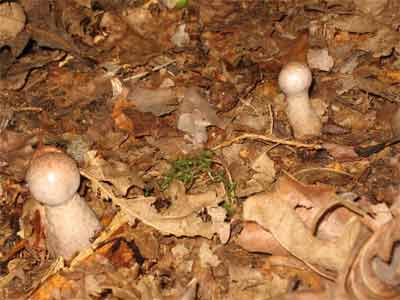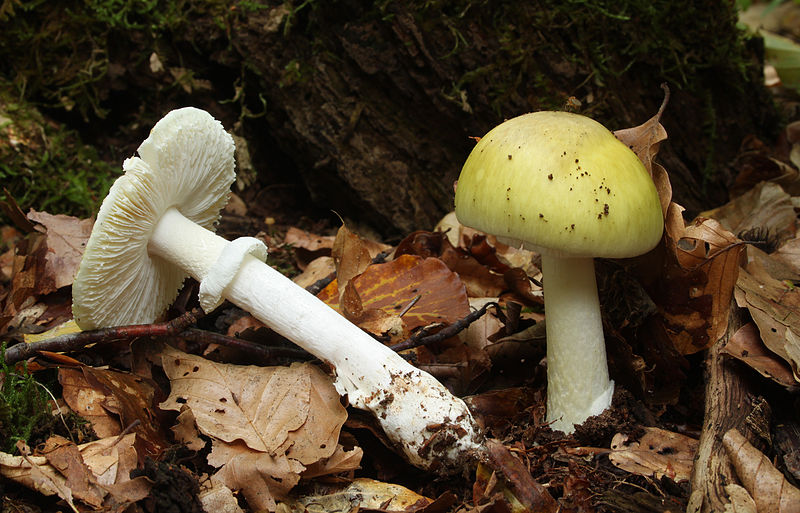Cep this way…
By Ruth D’Alessandro, The Wildlife Gardener The Wildlife Gardeners have had enough of cutting mixed hedgerows. We want to get out. It’s September, it has been raining, it’s warm, it must be time for mushrooms! We headed to woodlands on the Surrey/Kent border where we had surreptitiously followed a wicker-basket-and-knife-bearing German couple last year. And we were not disappointed. The first fungi were entertaining rather than edible. Just what are these funny little grey Halma-piece shaped mushrooms?

And this beautiful shining white one looks tempting:

…until you notice the volva (cup-shaped sheath) at its base. Although a volva is visible on the edible Caesar’s mushroom (Amanita caesarea), deadly Death Caps (Amanita phalloides) and Destroying Angels (Amanita virosa) have volvae, and for that reason I wouldn’t consider touching this mushroom. By the speckledy crackling on its cap, I’m guessing that this too is an Amanita species, and if one of our readers ID’d it as a Destroying Angel I wouldn’t be at all surprised. But all was not poison and destruction. As we wandered deep into the wood through bracken and wild bilberry bushes, we came across the occasional oak tree among the beeches and pines. And under these, we found the ultimate mushroom hunters’ prize: ceps!

Ceps, porcini or penny bun mushrooms (Boletus edulis) are big, meaty, earthy, utterly delicious mushrooms, beloved of Italians and foodies at London’s Borough Market (who pay
- Spurn Spawn! - 26th February, 2014
- Bluebells on wheels: axles of evil? - 2nd February, 2011
- Raising the ba: Wildlife and the Ancient Egyptian Book of the Dead - 8th January, 2011


Thanks, Andy – yes it has been a very good year for ceps – we even found a big one just outside our scout hut! We generally eat all we find, but I did dry a couple of finely-sliced bigger ones on a very low heat in a fan oven for several hours. They have to be absolutely dry otherwise they go mouldy.
I don’t know the ins and outs and whereabouts for selling foraged mushrooms, but I’m sure The Ranger will have something to say!
Congrats on the ceps. I have been picking these for a good 20 years, chucking virtually all for a few years until I was sure I got them right. Those ceps in the pix, including the giant (never seen one that big myself) are definitely ceps. Satan’s bolete is very distinctive, very red, and turns alarming shades when the flesh is cut, almost demanding to be avoided. that cep is simply reddish brown. Ceps, like all mushrooms have very widely varying appearance according to their age and situation.
I have found so many ceps this year — more than ever in my experience — I am trying to see where I can sell them (which is how I found this site) — in London. I would love to dry them all, and make cep powder too, which I have heard about recently, but I doubt my family can take the awful, socky, smell for the week or so it takes to dry them properly. They are fresh today (about 3 or 4 kilos, not including the 3 or 4 kg I already have drying) and I am driving to London tomorrow. Here’s to the Scottish Borders where real food is on the hoof or in cellophane, and the lack of interest in mushrooms is amazing.
White mushroom ID courtesy of @SussexWildlifeTrust: it’s probably a False Death Cap (Amanita Citrina), not particularly poisonous, but we’ll leave well alone anyway.
Not at all, Steve – the comments are there for lively discussion. I’m still intrigued by whether your bolete had a white cap – I keep seeing pics of Devil’s Boletes on grassland. Apparently they are off the Red Data List now as they have reached their Species Action Plan targets.
Thanks to both of you for your assistance (it was rude of me to intrude on your post, Ruth!)
Wise comment too, by David on the indigention provoked by uncertainty.
Ha! How true,Dave. As soon as Mr WG started complaining, MY innards seemingly began to play up! But we’re still alive, so that’s the main thing. Horn of plenty – mmm, that’s one I’d like to find too.
I think more people suffer indegestion from worrying whether they have ID’d the mushrooms they have just eaten correctly than from the effect of the mushrooms themselves!
I found some horn of plenty a couple of years ago, like you chanterelles but black. Nothing you can really confuse them with and very tasty!
I have indeed seen a Devils Bolete, a fearsomely large thing it was too. Looks similar to Steve’s photo, but very unlikely, unless it was under a holm oak which, given the nice calcareous grassland sward in the photo I doubt very much.
Hi Steve! Mr WG is complaining of a dodgy tummy, but he did buy and eat some reduced-price pate that looked green yesterday… I feel fine (so far :-P). I think your fungi are field mushrooms (top) and certainly one of the boletes (bottom), but not a cep as the stalk is red. Could be a Scarletina, but if the top of the cap was white you may just have spotted a very rare (poisonous) Devil’s Bolete.
Ranger – you’ve seen a Devil’s Bolete – was it anything like Steve’s?
Yum! If you don’t post in future, we’ll know you got the ID wrong.
My own post today shows some large fungi, some of which may well be ceps -I never realised they grew so large.